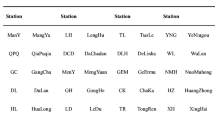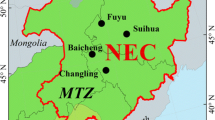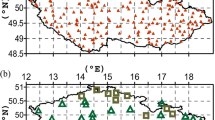Abstract
Long-term trends in soil temperature are important, but rarely reported, as a sensitive climate indicator and its impact on biological, chemical, and physical processes that occur in the soil. In this study, the simple linear regression and nonparametric Mann–Kendall (MK) trend test were employed to identify trends in monthly air and soil temperature anomalies (ATA and STA, respectively) time series at 5–100 cm depths of a soil profile, based on long-term (1987–2016) observation data of meteorological station of Bajgah Agricultural Experimental station, located in a semi-arid region in Iran. The results indicated a significant warming trend in ATA for February–October, with the highest and lowest rate of warming in March (0.103 °C year−1) and December (− 0.001 °C year−1), respectively. This study further revealed a general and strong increase in monthly means of STA over the studied period. The rates of soil temperature warming trend were 2–3 times greater than those of air temperature. The greatest soil warming increases with the rates of 0.20 and 0.19 °C year−1 were, respectively, observed at 5 and 10 cm soil depths in July. The applied linear trend indicated that the STA at 10 and 30 cm depths have warmed during May–October. In addition, the MK test revealed a significant trend in STA at 10 cm depth in March. Such significant warming trends in subsurface soil depths including 50 and 100 cm were observed for June–December during the whole period.









Similar content being viewed by others
References
Al Nakshabandi G, Kohnke H (1965) Thermal conductivity and diffusivity of soils as related to moisture tension and other physical properties. Agric Meteorol 2:271–279
Banimahd S, Zand-Parsa S (2013) Simulation of evaporation, coupled liquid water, water vapor and heat transport through the soil medium. Agr Water Manag 130:168–177
Barman D et al (2017) Soil temperature prediction from air temperature for alluvial soils in lower Indo-Gangetic plain. Int Agrophys 31:9–22
Beltrami H, Ferguson G, Harris RN (2005) Long-term tracking of climate change by underground temperatures. Geophys Res Lett 32:L19707
Boone RD, Nadelhoffer KJ, Canary JD, Kaye JP (1998) Roots exert a strong influence on the temperature sensitivity of soil respiration. Nature 396:570–572
Burton AJ, Pregitzer KS, Zogg GP, Zak DR (1998) Drought reduces root respiration in sugar maple forests. Ecol Appl 8:771–778
Campbell GS (1985) Soil physics with BASIC: transport models for soil–plant systems, vol 14. Elsevier, Amsterdam
Ceppi P, Scherrer SC, Fischer AM, Appenzeller C (2012) Revisiting Swiss temperature trends 1959–2008. Int J Climatol 32:203–213
Chudinova SM, Frauenfeld OW, Barry RG, Zhang T, Sorokovikov VA (2006) Relationship between air and soil temperature trends and periodicities in the permafrost regions of Russia. J Geophys Res Earth 111:F02008
Dinpashoh Y, Mirabbasi R, Jhajharia D, Abianeh HZ, Mostafaeipour A (2013) Effect of short-term and long-term persistence on identification of temporal trends. J Hydrol Eng 19:617–625
Du J, Li C, Liao J, Pa L, Lu H (2007) Responses of climatic change on soil temperature at shallow layers in Lhasa from 1961 to 2005. Meteorol Mon 33:61–67
El-Nesr MN, Abu-Zreig MM, Alazba AA (2010) Temperature trends and distribution in the Arabian Peninsula. Am J Environ Sci 6:191–203
Euskirchen E et al (2006) Importance of recent shifts in soil thermal dynamics on growing season length, productivity, and carbon sequestration in terrestrial high-latitude ecosystems. Glob Change Biol 12:731–750
Gao H, Shao M (2015) Effects of temperature changes on soil hydraulic properties. Soil Tillage Res 153:145–154
Ghasemi AR (2015) Changes and trends in maximum, minimum and mean temperature series in Iran. Atmos Sci Lett 16:366–372
Gilbert RO (1987) Statistical methods for environmental pollution monitoring. Van Nostrand Reinhold Co., New York
Gocic M, Trajkovic S (2013) Analysis of changes in meteorological variables using Mann–Kendall and Sen’s slope estimator statistical tests in Serbia. Glob Planet Change 100:172–182
Hamed KH, Rao AR (1998) A modified Mann–Kendall trend test for autocorrelated data. J Hydrol 204:182–196
Hansen J, Ruedy R, Sato M, Lo K (2010) Global surface temperature change. Rev Geophys 48:RG4004
Harris RN, Chapman DS (2001) Mid-latitude (30°–60°N) climatic warming inferred by combining borehole temperatures with surface air temperatures. Geophys Res Lett 28:747–750
Horton R, Ochsner T (2011) Soil thermal regime handbook of soil sciences. In: Huang PM, Li Y, Sumner ME (eds) Handbook of soil science: properties and processes, chap 9-1, vol 1. CRC Press, Boca Raton
Huang S, Pollack HN, Shen P-Y (2000) Temperature trends over the past five centuries reconstructed from borehole temperatures. Nature 403:756–758
Jungqvist G, Oni SK, Teutschbein C, Futter MN (2014) Effect of climate change on soil temperature in Swedish boreal forests. PLoS ONE 9:e93957
Kaspar T, Bland WL (1992) Soil temperature and root growth. Soil Sci 154:290–299
Kendall MG (1948) Rank correlation methods. Griffin, Oxford
Kirschbaum MU (1995) The temperature dependence of soil organic matter decomposition, and the effect of global warming on soil organic C storage. Soil Biol Biochem 27:753–760
Kousari MR, Ahani H, Hendi-zadeh R (2013) Temporal and spatial trend detection of maximum air temperature in Iran during 1960–2005. Glob Planet Change 111:97–110
Liao X, Su Z, Liu G, Zotarelli L, Cui Y, Snodgrass C (2016) Impact of soil moisture and temperature on potato production using seepage and center pivot irrigation. Agric Water Manag 165:230–236
Majorowicz JA, Skinner WR (1997) Anomalous ground warming versus surface air warming in the Canadian Prairie provinces. Clim Change 35:485–500
Mann HB (1945) Nonparametric tests against trend. Econometrica 13:163–171
Merdun H (2012) Effects of different factors on water flow and solute transport investigated by time domain reflectometry in sandy clay loam field soil. Water Air Soil Pollut 223:4905–4923
Modarres R, da Silva VdPR (2007) Rainfall trends in arid and semi-arid regions of Iran. J Arid Environ 70:344–355
Peng X, She Q, Long L, Liu M, Xu Q, Zhang J, Xiang W (2017) Long-term trend in ground-based air temperature and its responses to atmospheric circulation and anthropogenic activity in the Yangtze River Delta, China. Atmos Res 195:20–30
Pollack HN, Smerdon JE (2004) Borehole climate reconstructions: spatial structure and hemispheric averages. J Geophys Res Atmos 109:D11106
Putnam SN, Chapman DS (1996) A geothermal climate change observatory: first year results from Emigrant Pass in northwest Utah. J Geophys Res Solid Earth 101:21877–21890
Reddell P, Bowen G, Robson A (1985) The effects of soil temperature on plant growth, nodulation and nitrogen fixation in Casuarina cunninghamiana Miq. New Phytol 101:441–450
Ruml M et al (2017) Observed changes of temperature extremes in Serbia over the period 1961–2010. Atmos Res 183:26–41
Saboohi R, Soltani S, Khodagholi M (2012) Trend analysis of temperature parameters in Iran. Theor Appl Climatol 109:529–547
Sen PK (1968) Estimates of the regression coefficient based on Kendall’s tau. J Am Stat Assoc 63:1379–1389
Shirvani A (2015) Change point analysis of mean annual air temperature in Iran. Atmos Res 160:91–98
Shirvani A (2017a) Change in annual precipitation in the northwest of Iran. Meteorol Appl 24:211–218
Shirvani A (2017b) Change point detection of the Persian Gulf sea surface temperature. Theor Appl Climatol 127:123–127
Shirvani A, Moradi F, Moosavi AA (2015) Time series modelling of increased soil temperature anomalies during long period. Int Agrophys 29:509–515
Soltani S, Saboohi R, Yaghmaei L (2012) Rainfall and rainy days trend in Iran. Clim Change 110:187–213
Some’e BS, Ezani A, Tabari H (2012) Spatiotemporal trends and change point of precipitation in Iran. Atmos Res 113:1–12
Sun Q et al (2014) Variations in global temperature and precipitation for the period of 1948 to 2010. Environ Monit Assess 186:5663–5679
Tabari H, Talaee PH (2011) Analysis of trends in temperature data in arid and semi-arid regions of Iran. Glob Planet Change 79:1–10
Tomlinson GH (1993) A possible mechanism relating increased soil temperature to forest decline. Water Air Soil Pollut 66:365–380
von Storch H, Zwiers FW (2002) Statistical analysis in climate research. Cambridge University Press, Cambridge
Zhang T, Barry RG, Gilichinsky D, Bykhovets S, Sorokovikov V, Ye J (2001) An amplified signal of climatic change in soil temperatures during the last century at Irkutsk, Russia. Clim Change 49:41–76
Zheng D, Hunt ER Jr, Running SW (1993) A daily soil temperature model based on air temperature and precipitation for continental applications. Clim Res 2:183–191
Acknowledgements
The authors greatly appreciate an anonymous reviewer for his/her useful comments and suggestions. The authors would also like to thank Mrs. Sousan Esfandiari, Department of Water Engineering, Shiraz University, for providing data.
Author information
Authors and Affiliations
Corresponding author
Rights and permissions
About this article
Cite this article
Shirvani, A., Moradi-Choghamarani, F., Zand-Parsa, S. et al. Analysis of long-term trends in air and soil temperature in a semi-arid region in Iran. Environ Earth Sci 77, 173 (2018). https://doi.org/10.1007/s12665-018-7372-z
Received:
Accepted:
Published:
DOI: https://doi.org/10.1007/s12665-018-7372-z




